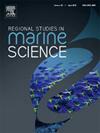海水调节水泥作为珊瑚幼虫沉降的可行基质
IF 2.1
4区 环境科学与生态学
Q3 ECOLOGY
引用次数: 0
摘要
水泥基材料通常用于人工鱼礁,但由于其表面pH值升高,这对幼虫的招募不理想,因此这种应用遇到了挑战。为了解决这一问题,本研究采用了简单的海水预处理工艺来降低水泥表面pH值,并考察了达到正常海水pH值范围所需的时间。将普通硅酸盐水泥与牡蛎壳粉按1:0、1:10、1:20、1:30的质量比配制成四组实验砖。与这些瓷砖直接接触的海水的初始pH值分别为10.6、10.0、9.6和9.0。在海水在黑暗中调节一周后,所有测试的比例,包括纯水泥(1:0),对海水pH值的影响都有所下降,恢复到8.1的自然水平。随后,在昼夜循环下,用条件瓦诱导鹿角虫珊瑚幼虫在三天内定居。在所有测试比例中,瓷砖显示出统计学上相似的珊瑚沉降率,每块瓷砖上平均观察到0.53-0.86只幼虫(15 mm × 15 mm)。这些发现表明,当给予足够的预处理时间来调节表面pH值时,水泥可以成为珊瑚幼虫招募和人工珊瑚礁实施的合适基质。本文章由计算机程序翻译,如有差异,请以英文原文为准。
Seawater-conditioned cement as a viable substrate for coral larval settlement
Cement-based materials are commonly used in artificial reefs, but this application encounters a challenge due to their elevated surface pH, which is not ideal for larval recruitment. To address this concern, the present study employed a simple seawater pre-conditioning process to lower the cement surface pH and examined the time required to reach the normal seawater pH range. Four groups of experimental tiles were prepared by mixing ordinary Portland cement with oyster shell powder at mass ratios of 1:0, 1:10, 1:20 and 1:30. Seawater in immediate contact with these tiles displayed initial pH levels of 10.6, 10.0, 9.6 and 9.0, respectively. Within a week of seawater conditioning in darkness, all tested ratios, including pure cement (1:0), displayed a decrease in their impact on seawater pH, which returned to the natural level of 8.1. The conditioned tiles were subsequentially used to induce settlement of coral larvae of Acropora tumida over a three-day period under a day-night cycle. Across all tested ratios, the tiles exhibited statistically similar rates of coral settlement, with an average of 0.53–0.86 larvae observed on each tile (15 mm × 15 mm). These findings suggest that when given sufficient time of pre-conditioning to adjust the surface pH, cement can be a suitable substrate for coral larval recruitment and for implementation in artificial reefs.
求助全文
通过发布文献求助,成功后即可免费获取论文全文。
去求助
来源期刊

Regional Studies in Marine Science
Agricultural and Biological Sciences-Ecology, Evolution, Behavior and Systematics
CiteScore
3.90
自引率
4.80%
发文量
336
审稿时长
69 days
期刊介绍:
REGIONAL STUDIES IN MARINE SCIENCE will publish scientifically sound papers on regional aspects of maritime and marine resources in estuaries, coastal zones, continental shelf, the seas and oceans.
 求助内容:
求助内容: 应助结果提醒方式:
应助结果提醒方式:


